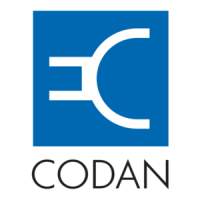Brief description
HF SSB Transceiver 9323/9360/9390/9780 Technical Service Manual 3-5
Receive path
PA and Filter PCB
The received signal from the antenna passes through a PA low-pass filter, onto the
transmit/receive relay. It is then sent to the receiver input on the Rx/Exciter PCB.
Rx/Exciter PCB
From the receive input, the signal passes through a selected high-pass filter and is
fed either directly to a 30 MHz low-pass filter or via an RF amplifier. The output
of the low-pass filter is fed to the input of the first balanced mixer. Here it mixes
with the local oscillator VCO1 to produce an IF signal centred on 45 MHz.
The 45 MHz signal is filtered using a 15 kHz wide band-pass filter before being
applied to the second balanced mixer. The signal mixes with a second local
oscillator VCO2 producing an IF signal centred on 455 kHz.
The output of the second mixer divides into two paths:
• the main path passes the signal through a noise gate to a 2.5 kHz sideband filter
where only the wanted sideband passes to the high gain AGC controlled IF
amplifier
• the second path passes the signal through an amplifier that detects noise and
controls the noise gate to remove impulse noise, such as car ignition, from the
455 kHz signal
The amplified 455 kHz signal is demodulated to produce an audio signal. It is then
amplified. The amplified audio signal operates an AGC circuit. This controls the
IF amplifier gain to prevent overloading when receiving strong signals. It is also
used to maintain a constant audio output with changing input signals.
The amplified audio signal is fed via a mute gate to the volume control. The mute,
when enabled, removes the receiver noise from the speaker. When speech is
detected, the gate in the audio line closes to allow the signal to be heard.
The signal from the volume control is applied to a power amplifier IC to drive the
transceiver’s loudspeaker.

